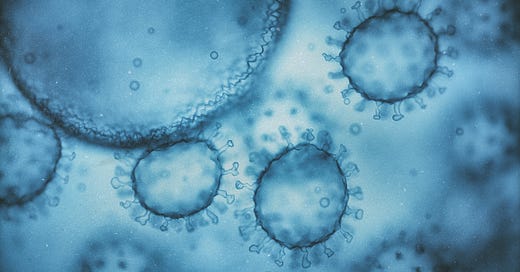
What Makes SARS-CoV-2 the Perfect Pathogen
Who bears responsibility for the COVID-19 pandemic?
While a detailed forensic accounting will ultimately reveal the contribution of people and institutions to the current crisis, we must take care not to lose sight of the most important culprit: the unique character of the virus itself.
To a first approximation, a virus can be defined by two parameters:
R0 (“R-naught”) is the basic reproduction number, which measures how transmissible the virus is. Meaning: If you’re a typical patient who has knowingly or unknowingly contracted the virus, how many new people will you infect on average?
The Case Fatality Rate (CFR) measures how lethal the virus is. Meaning: If you are diagnosed with an infection, how likely are you to die?
Viruses that are extremely deadly, such as MERS and ebola, have tended to be relatively self-limiting, in part because they are so lethal. Less deadly viruses, such as the measles, are incredibly contagious—but not especially deadly.
SARS-CoV-2, the virus behind COVID-19, occupies what former FDA Commissioner Scott Gottlieb calls “the middle space.” It is, he explains, “lethal enough to be very virulent, very threatening, but transmissible enough that it could reach around the world.” It is, in a phrase, “the perfect pathogen.”
Beyond it’s descriptive numbers, SARS-CoV-2 harbors additional characteristics which make it especially problematic.
First there is its protean clinical presentation. Some people who are afflicted with COVID-19 are almost immediately laid low, acutely aware that something is profoundly wrong with them. Others seem to endure infection without any symptoms whatsoever.
A recent study performed at two obstetric delivery centers in New York City during the height of the pandemic identified SARS-CoV-2 in 33 of 214 pregnant women; only 4 of the 33 exhibited symptoms—the vast majority were asymptomatic.
Another just-reported study examined a statistically representative sample of 3,330 people in early April in Santa Clara, California, and looked for evidence of an immune response to SARS-CoV-2—a measure of how many had been exposed to the virus (perhaps without even knowing it) and had recovered. The result: between 2 percent and 3 percent of the overall population, a figure that’s “50-85-fold more than the number of confirmed cases,” according to the authors.
In other words, at least according to this estimate, far more people are exposed to the virus than are getting diagnosed. In part, this could simply reflect the lack of adequate testing—many of these patients might have been demonstrably sick. Or it could suggest that the percentage of asymptomatic cases is much higher than we currently believe. Or, despite the best efforts of the researchers, the sample may have been unknowingly skewed in such a way that makes extrapolation from this one study not especially solid.
But wait, there’s more.
As if the problem of asymptomatic patients wasn’t problematic enough, consider fresh data suggesting that among COVID-19 patients who do show symptoms, the most contagious time is likely one to two days prior to symptom onset. Which, if true, would mean that stopping the spread through measures such as temperature checks would be difficult.
Taken together, these three studies highlight the challenge of containment, especially in the absence of robust testing. Relying on either self-reporting (even assuming good self-diagnostics and total honesty) or temperature checks might be insufficient to identify many COVID-19 patients who will spread the disease.
And even in the cases of patients who remain asymptomatic, they might transmit the virus to more vulnerable people.
These results highlight the critical importance of widespread testing—as business leaders, multiple cross-functional task forces, and governors, including those from rural states, continue to call for. Vice President Pence insists that the federal government “has no higher priority” than expanding testing. That is good to know. Not good is that our testing capacity is still far below where it needs to be.
But even if we eventually get testing right, we’re still only stalling. Life won’t durably return to normal until we achieve what’s known as herd immunity. If we are lucky, this will be achieved through a vaccine. But again, this virus may conspire to make things difficult.
First, it’s unclear how long immunity lasts for this category of virus, technically known as a betacoronavirus.
Immunity to SARS-CoV-1 is relatively durable, but immunity to two other betacoronaviruses, HCoV-OC43 and HCoV-HKU1, wanes within a year. The point is that even after exposure to the virus—or a future vaccine—it’s possible that someone could become immune and then, in a year, become susceptible again.
It’s also possible that coronaviruses could mutate over time, as influenza viruses do (influenza is a different class of virus, but carries a similar genetic payload). If that is the case, it would require constant vaccine development—the way we need to design a new flu shot each year, and generally only get it partially right.
COVID-19 has challenged the country on many levels and in any catastrophe, it’s natural to look for some figure to blame.
But I suspect that right now, we would do well to redirect much of that energy toward efforts to understand and defeat the real enemy: the perfect pathogen.
And also: be kind to each other.
Corrections: An earlier version of this story's headline incorrectly referred to SARS-CoV-1 instead of SARS-CoV-2. The original text said "infected" (which technically describes something called the "Infection Fatality Rate"), rather than "diagnosed with infection," the correct measure for CFR; to officially be a "case," you must be formally diagnosed.










